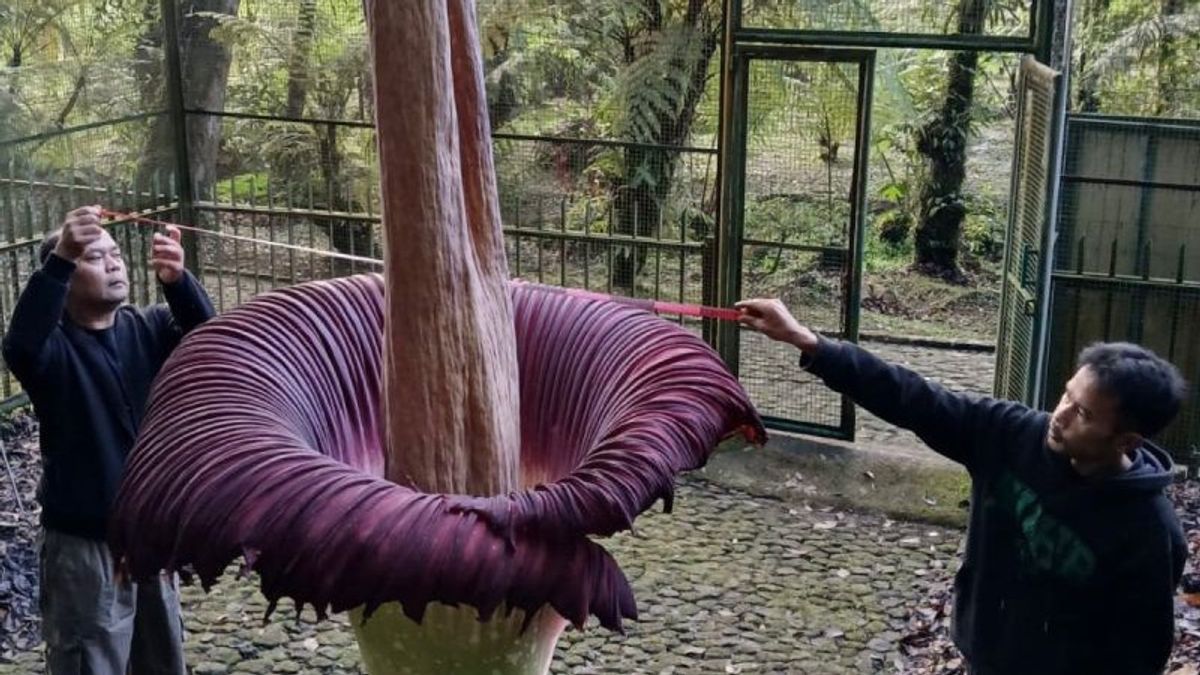JAKARTA - Amorphophallus titanum Becc or known as the corpse flower has bloomed again for the seventh time in the Cibodas Botanical Gardens, Cianjur, West Java.
Young Researcher at the Center for Biosystematics Research and Evolution of the National Innovation Riser Agency (BRIN), Destri, said that the corpse flower that is currently in bloom is the holding of the corpse flower number 27.
"The plant bed was collected by the late R. Subekti Purwantoro, and friends in 2000 from the Manau River, Batang Hakiri, the Kerinci Seblat National Park Area, West Sumatra," said Destri at the Cibodas Botanical Gardens, Sunday, May 26, which was confiscated by Antara.
Plants that have towering flower shapes with tuna or spadiks surrounded by flower reverberations (spatha) which when they bloom are red in color, including the Indonesian endemic Sumatran native plant. This plant in addition to having a distinctive aroma such as the smell of carrion, also has the largest flower in the world or referred to as the giant inflorescent in the world.
This plant, said Destri, has a four-year flowering period with three growth phases, namely the vegetative (leaved), generative (flowered) phase, and the durman phase (rest). When this plant blooms, its beauty can only be enjoyed for three to five days.
"This is what attracts people's attention to see it," said Destri.
He said the flower first bloomed in 2003 with a flower height of 2.7 meters. Then in 2007, the flower bloomed again with a height of 3.17 meters.
Four years later, said Destri, in 2011 it will bloom again to a height of 3.2 meters, in 2016 it will reach 3.735 meters, in 2017 it will reach 3.4 meters, and in 2020 it will reach 3.52 meters.
"Dams of corpse flowers that bloom today are estimated to be 35 years old," he said.
According to data from the monitoring of the scientific collection management unit of the Cibodas Botanical Gardens, Destri said, flower shoots that are currently in bloom began to be observed on February 28, 2024.
"This flower blooms perfectly on Saturday (May 25) at 22:03 WIB, with a spadik height of 340 centimeters or 3.40 meters and a spatanya width of 159 centimeters," he explained.
SEE ALSO:
He said, in 2016 the individual flower height of this plant reached 3.735 meters. However, after that, the flower height has not yet reached 3.7 meters or more.
Destri said, when it blooms in 2016 and immediately blooms again in 2017, it occurs without any vegetation phase. Thus, it affects food reserves in tubers, because when a single flower flower flower will require great energy.
Therefore, this plant needs time to supply energy reserves in Umbi. Until one day it can return to the same conditions as in 2016 or maybe more," said Destri.
The plant, which is included in the category of endangered species based on an assessment from the 2018 International Union for Conservation of Nature (IUCN), is also protected by its existence under Government Regulation Number 7 of 1999.
The English, Chinese, Japanese, Arabic, and French versions are automatically generated by the AI. So there may still be inaccuracies in translating, please always see Indonesian as our main language. (system supported by DigitalSiber.id)

















